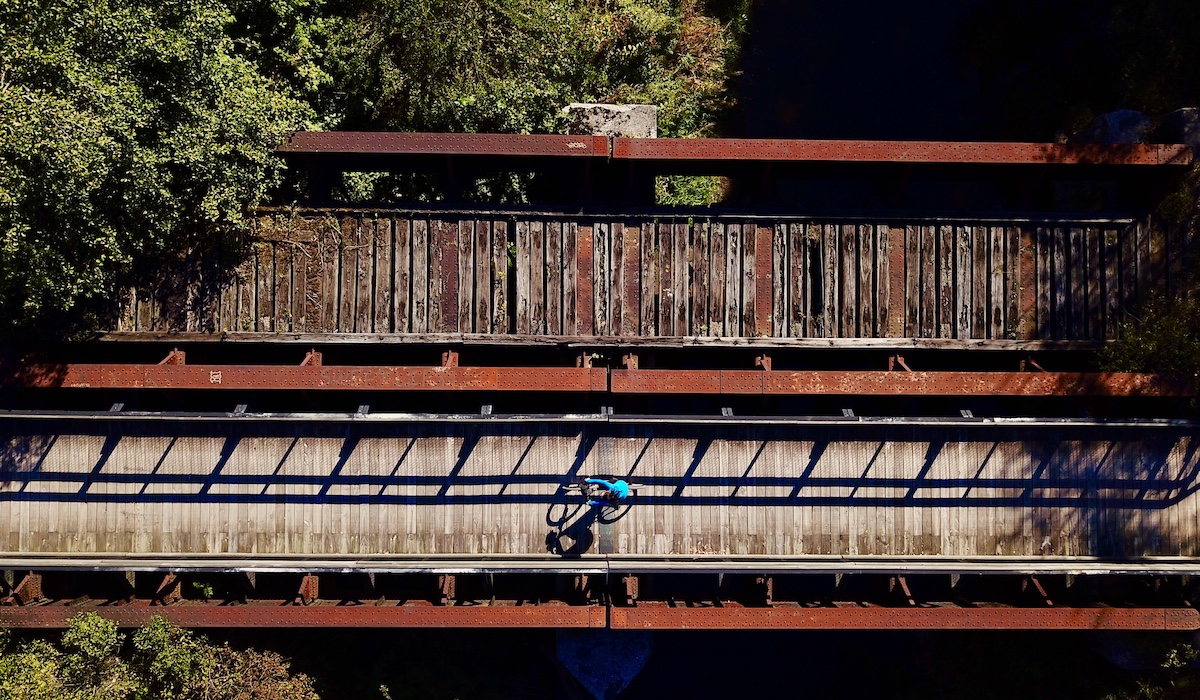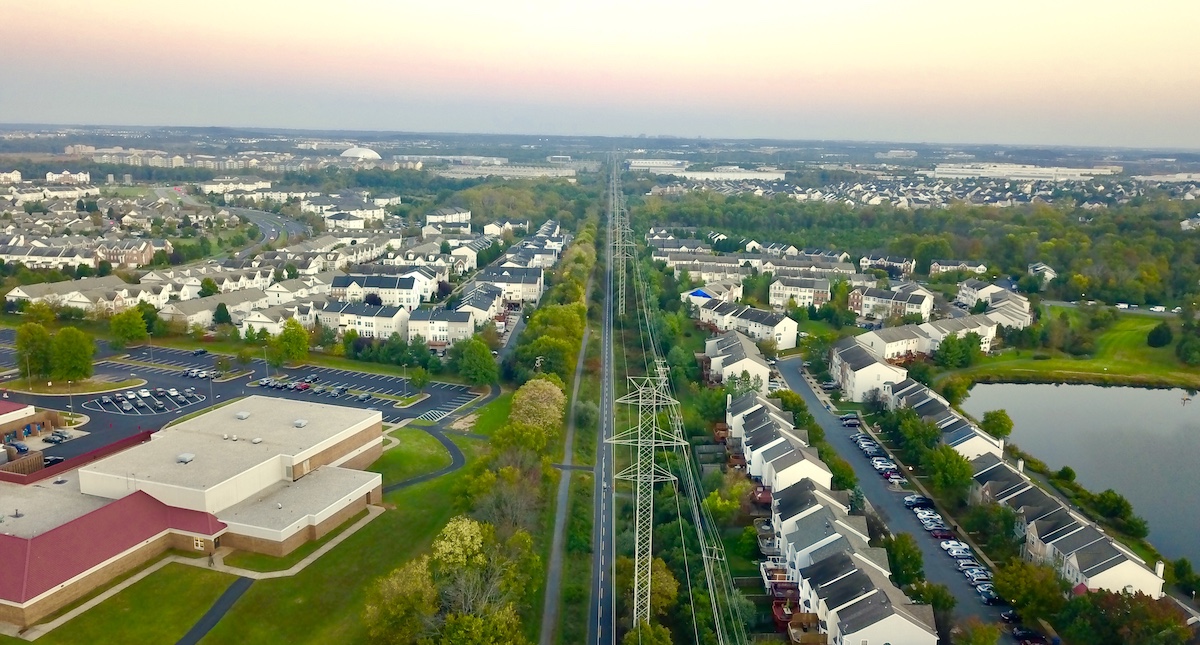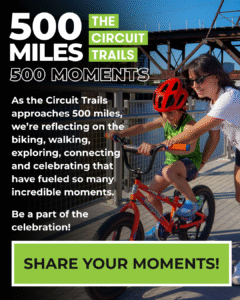Staying Active While We Practice Social Distancing
Authored By: The Circuit Trails | March 25, 2020

This blog was written by Brandi Horton, Vice President of Communications for Rails-to-Trails Conservancy, and it first appeared on their blog in March 2020.
Over the past days and weeks, life in America—and around the world—has changed dramatically.
As we all grapple with the uncertainty surrounding COVID-19, one message has been abundantly clear: Social distancing is essential. Now, communities are taking extensive actions to keep their communities as safe as they can. Concerts, festivals, schools, restaurants, bars, gyms—the social hubs of our communities—are canceled or closing. In the San Francisco Bay Area, millions of people are under a “shelter-in-place” order. People who can are working remotely. Others are counting on their neighbors to keep their distance as they report to work for essential jobs—health care workers, first responders and many others.
“Social distancing is critical; it’s the one thing that will stop the spread,” said Dr. Joseph B. McCormick, regional dean and James H. Steele professor of epidemiology at the University of Texas School of Public Health (UTHealth) in Brownsville.*
Our lives and our communities have been upended in ways we never could have imagined, and in some cases, the questions outnumber the answers. At Rails-to-Trails Conservancy (RTC), we’ve heard from many who aren’t sure if it’s okay to be outside, or on the trail, but public health experts are quickly sharing information about the value of being active, especially outdoors, right now.
What to Consider
In many communities, here in the United States and globally, officials are encouraging people to seek out both physical activity and time outside. The San Francisco Bay Area shelter-in-place order includes an exemption specifically for “engaging in outdoor activity, such as walking, hiking, or running provided that you maintain at least six feet of social distancing.” In New York, state parks are now free, and residents are encouraged to use parks and trails as they seek opportunities to safely be active. In Paris, physical activity, taking the kids outside and walking a pet are all considered essential.
What Is Social Distancing?
According to John Hopkins Medicine, social distancing is deliberately increasing the physical space between people, staying at least six feet apart, to avoid spreading illness.
“I have heard guidance that it is important to keep up daily routines even though normal schedules are disrupted. This includes bedtime and wake times, healthy meals, and physical activity,” said Dr. James F. Sallis, distinguished professor emeritus of family medicine and public health at the University of California, San Diego, and an RTC board member.
As the days of social distancing add up, it’s becoming more and more evident just how important it will be to have access to outdoor places as we work to maintain our nation’s health and wellness. Trails are increasingly being counted on as places where people can engage in regular physical activity and find respite, while practicing social distancing. In some places, trails are becoming primary transportation routes—and walking and biking the most appropriate way to travel.
Carolyn C. Cannuscio, ScD, a social epidemiologist for the Center for Public Health Initiatives at the University of Pennsylvania, was quoted in the New York Times as saying, “We’re trying to avoid face-to-face contact with other people, so all of our decisions should be made with that in mind. I would suggest that people walk at times that streets are less busy, walk in locations where there are fewer people and there’s an opportunity to spread out, and don’t stop and talk with your neighbors.”
Physical Activity Is Essential

Great Allegheny Passage | Pennsylvania & Maryland, photo by Milo Bateman
“Being active has profound mental health benefits, and enhancing psychological health is especially critical in times of stress, which this certainly is,” said Dr. Sallis. “Each session of physical activity boosts mood and reduces anxiety, so making sure you get activity every day can be a partial antidote to worrisome news reports.”
Drs. Sallis and McCormick agree that regular physical activity is effective at preventing symptoms of depression and anxiety, and for those who are already feeling distress, physical activity is as effective as medications and psychotherapy. Recent studies indicate exercise and time spent in nature may be even better for mental health than exercising indoors.
“This is a good reason to keep visiting your local trails,” added Dr. Sallis.
According to Dr. Sallis, when people are physically active, their muscles produce compounds that improve the functioning of the immune system and bring inflammation under control. Improving the immune system response to the virus and reducing inflammation when the immune system attacks the virus has the potential to reduce the severity of the illness and speed recovery.
While studies of the effects of exercise have not yet been conducted with COVID-19 patients, the effects of exercise on immunity and inflammation have been documented. Several studies indicate that each session of exercise produces a substantial release of chemicals that boost immunity and reduce inflammation.
Staying Up-to-Date: Public Health Guidance and Trail Status
As the situation surrounding COVID-19 is changing quickly from community to community, before visiting the trail, we recommend that you take precautions by doing the following:
- Follow the Centers for Disease Control and Prevention’s (CDC’s) most current public health and safety guidance at coronavirus.gov.
- Refer to the guidance provided by your local/state government for more specific information about your community.
- Check with the local trail management organization to confirm the status of trail facilities. While we expect many trails to remain open, it will be important to confirm before you head out. That contact information is available when accessing individual trail records at TrailLink.com.
- As you plan your trail outing, be prepared that some trails may have limited services, including closed facilities such as bathrooms, depots and visitor centers, and limited or no staff.
Getting Outside

W&OD Trail in Virginia, photo by Milo Bateman
As more and more people get creative about how to be physically active during this period of restricted activities, there are increasing reports of people turning to trails and parks to get outside, get some fresh air and sunlight, and find some respite from the moment.
“Exercise [outdoors] is very important under these circumstances. Going outside, you have some level of breeze—even if it’s very light. You have a lot of air dilution, that is air all around you that will dilute whatever is present. As long as you don’t come into close contact with someone, there is almost no way you’re going to get exposed outside,” said Dr. McCormick.
The general consensus of the moment, according to mounting reports from public health experts, is that it’s okay—it’s even encouraged—to go outside. The reality, though, is that guidelines about how best to prevent COVID-19 are changing quickly, and everyone should pay close attention to the authoritative guidance of the CDC as well as state and local public health officials.
Find a Local Trail on TrailLink
RTC’s trail-finder website and app, TrailLink.com, is free for anyone to use. The service offers information on more than 37,000 miles of multiuse trails nationwide, including trail maps, walking and biking directions to get to the trail, and contact information for local trail management organizations. As people are looking for places to get outside and be physically active, TrailLink.com is a reliable resource.
To further protect yourself, Dr. McCormick suggests bringing disinfecting wipes to clean any surfaces you come into contact with, using hand sanitizer while on the trail, avoiding touching your face, and washing your hands frequently when you have access to soap and water.
“For many people, walking, hiking or biking on trails will continue to be a valuable contributor to quality of life. Physical activity is great for the mind and body, and being out in nature can be a shot of joy that we need to get through this pandemic as gracefully as possible,” Dr. Sallis concluded.


